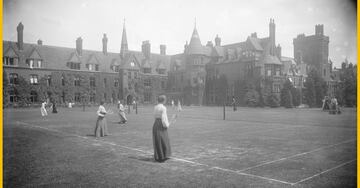Why is the tennis scoring system 15-30-40? How does it work?
Tennis is a globally beloved sport with a characteristic fan following, but have you ever wondered about the origin of its scoring system?

Tennis fans are probably happy that September has come since it has one of the busiest agendas in the ATP calendar, with the US Open played during this month.
The sport is easy to understand and may prove very attractive due to its intensity and fair play between the opponents, but the scoring system remains a mystery.
Here’s a breakdown of how an entire match is played and the theories about why points are counted with 15, 30, and 40 points.
How do tennis scores work?
Points, games, and sets split tennis matches. To emerge victorious in a non-Grand Slam tournament, a player must win two sets of six games (men and women), which require four points each. If it’s a GS tournament, men must secure three sets, while women will emerge victorious by winning two.
Players need to score four points to win a game, with the scores counted as 15, 30, and 40, followed by the winning point.
Players often find themselves tied at 40 points each - called a ‘deuce’ - meaning one has to score twice consecutively to win a game (advantage, game).
Once a player has secured a game, they must do this six times to win a set, with one having to win two more games than the opponent (6-1, 6-2, 6-3, or 6-4).
However, it may happen that both contenders have won five games each, so the ‘six-game rule’ to win a set disappears, as there should be a difference of two games; in this case, the set could be over with a 7-5 score.
If there’s a 6-6 game situation, a tie-break is played (the first to get to seven points with a difference of at least two takes the set with a 7-6 game score).
Why are tennis points 15, 30, and 40?
Why isn’t it 1 to 4 instead of 15, 30, 40, and game? One of the most accepted theories on this dates back to medieval France.
It is believed by many that the earliest version of tennis – known then as ‘Jeu de Paume’ – is responsible for the scoring system. The courts measured 45 feet on each side of the net. Each player would start at the back, but when they scored, they would move forward 15 feet.
After moving forward 15 feet twice, they could only move forward 10 feet (therefore a total of 40 rather than 45) to avoid being right against the net.
Another theory suggests clock faces were used to keep score, with a quarter move of the minute hand to indicate a score of 15, 30, and 45.

The theory goes that this was changed to 40 when the concept of winning a game by two points was introduced to make room for advantage, which was placed at 50 past the hour.
During medieval times, some clocks at French and English cathedrals did have minute dials and tolled every 15 minutes, so this theory can’t be completely ruled out.





